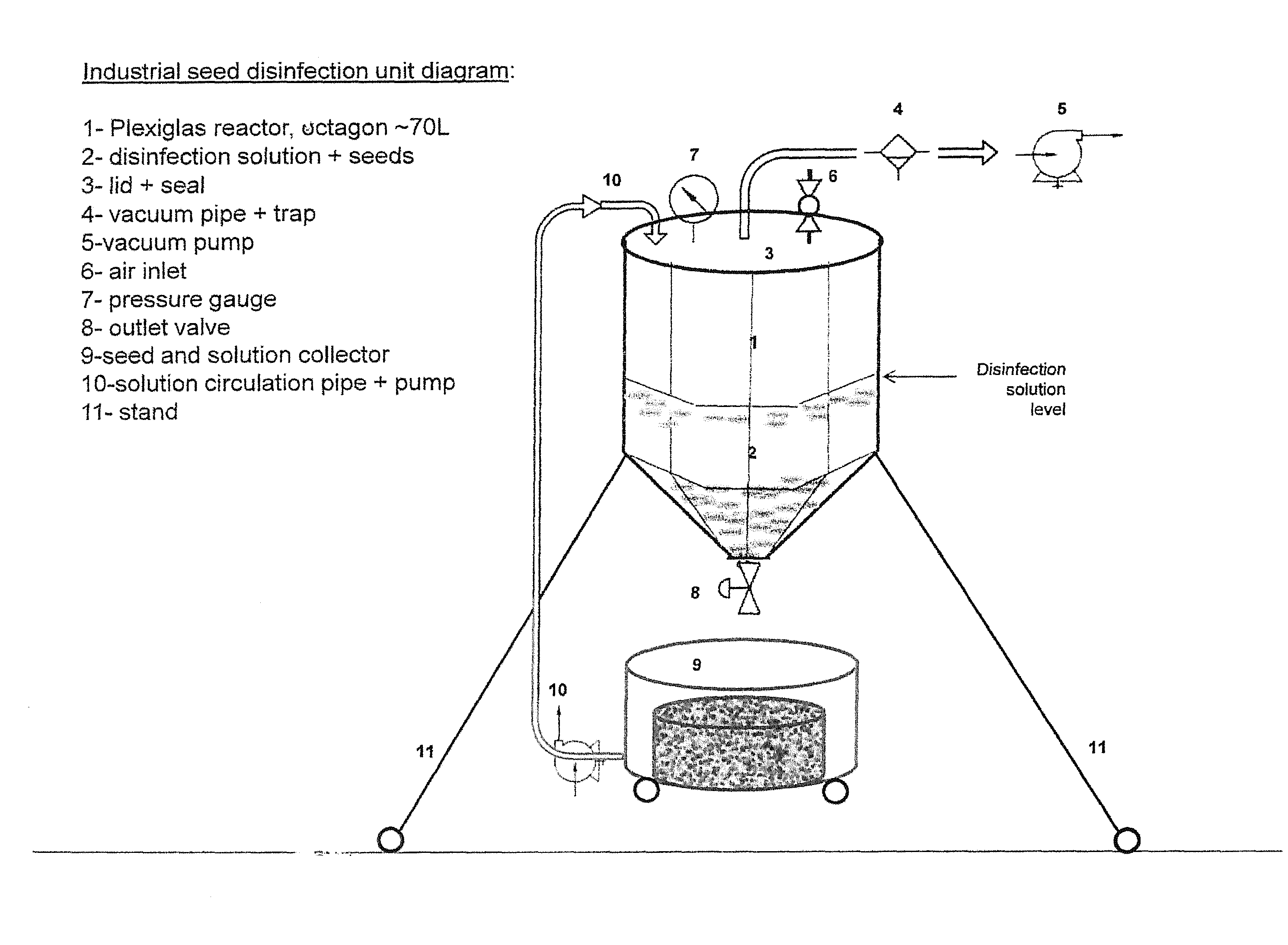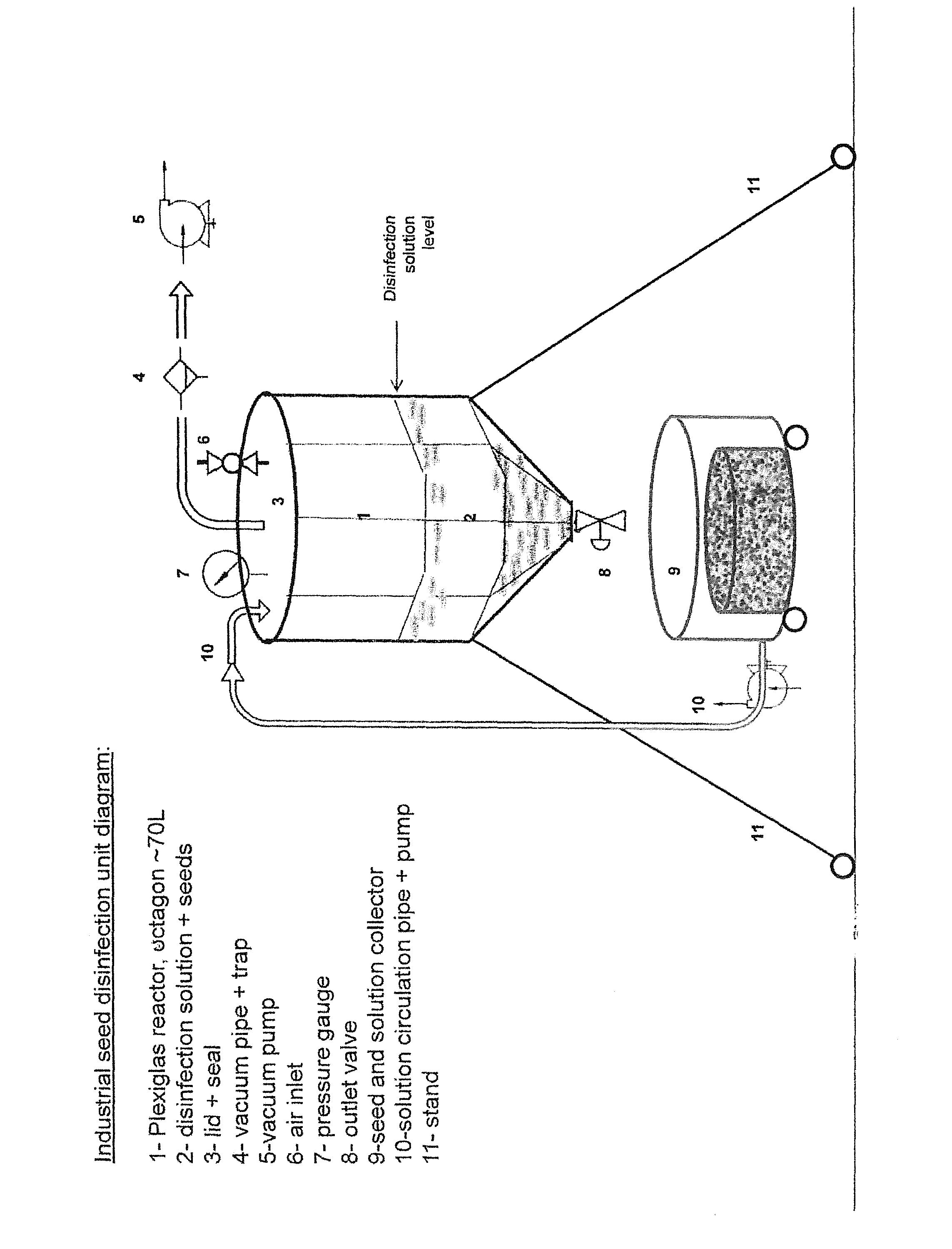Treatment for seeds disinfection
a technology for disinfection and seed, applied in the field of seed treatment, can solve the problems of reducing crop yield, deteriorating quality, and important economic losses in the year
- Summary
- Abstract
- Description
- Claims
- Application Information
AI Technical Summary
Benefits of technology
Problems solved by technology
Method used
Image
Examples
example 1
Disinfection of Watermelon Seeds Naturally Infected by Bacterial Fruit Blotch
[0094]Bacterial Fruit Blotch (BFB) is a disease caused by the bacteria Acidovorax citrulli that can be devastating for farmers as fruit losses can reach more than 90% of a production field. According to Walcott, R. R. 2005. The Plant Health Instructor. DOI: 10.1094 / PHI-I-2005-1025-02-http: / / www.apsnet.org / edcenter / intropp / lessons / prokatyotes / Pages / BacterialBlotch.aspx. Bacterial fruit blotch (BFB) affects the foliage at all growth stages and fruit of a wide range of cucurbitaceous hosts. Symptoms such as water-soaking on the undersides of cotyledons can be initially observed on cucurbit seedlings, between five and eight days after planting. BFB-associated lesions have a greasy appearance and persist under dry conditions, i.e., observable after mid-day. Water-soaked lesions start as discrete spots but then coalesce and extend along the veins of the cotyledons. They eventually dry to form elongated, dark to r...
example 2
Disinfection of Melon Seeds Naturally Infected by Bacterial Fruit Blotch
[0101]49 kilograms of melon seeds naturally infected by BFB where disinfected twice by a standard disinfection protocol (Na-Dichloroisocyanurate, 1% and 2% concentration; duration: 10 min; rinse 10 min). The disinfected seed were then tested for BFB and found still heavily infested. Batches of 4.5 kilograms of this seed lot were put in a 70 liter reactor (as described in FIG. 1) together with 20 liters of disinfecting solution comprising of Na-Dichloroisocyanurate at 0.5%.
[0102]A vacuum is applied and build up to about 500 mbar then released. This process of vacuum / de-vacuum is repeated, each time with an increase of the vacuum pressure by approximately 100 mbar, up to the maximum reachable vacuum pressure of about 975-985 mbar. This process leads to the formation of two seed fractions in the vessel: one sinking fraction and one floating fraction. The vacuum cycles continue until floating seeds are no longer sin...
example 3
Disinfection of Cucumber Seeds Naturally Infected by Cucumber Green Mild Mottle Virus (CGMMV)
[0110]In this case, cucumber seeds have been obtained from a commercial seed lot, naturally infected by CGMMV in the production field.
[0111]The seeds were disinfected by standard method and by vacuum infiltration method. In this case, vacuum is applied at maximal pressure of 975-985 mbar from the beginning. This process leads to the formation of two seed fractions in the vessel: one sinking fraction and one floating fraction. The vacuum cycles continue until floating seeds are no longer sinking. The floating seeds are then removed and discarded. This process takes 15-20 minutes.
[0112]In this case two chemicals were used. Tri Sodium Phosphate at 10% by standard disinfection (A) and by vacuum infiltration (B), Na-Dichloroisocyanurate at 0.4% by standard disinfection (C) and by vacuum infiltration (D) See table I for CGMMV ELISA assay results and germination results.
[0113]We also tested the eff...
PUM
| Property | Measurement | Unit |
|---|---|---|
| vacuum pressure | aaaaa | aaaaa |
| vacuum pressure | aaaaa | aaaaa |
| vacuum pressure | aaaaa | aaaaa |
Abstract
Description
Claims
Application Information
 Login to View More
Login to View More - R&D
- Intellectual Property
- Life Sciences
- Materials
- Tech Scout
- Unparalleled Data Quality
- Higher Quality Content
- 60% Fewer Hallucinations
Browse by: Latest US Patents, China's latest patents, Technical Efficacy Thesaurus, Application Domain, Technology Topic, Popular Technical Reports.
© 2025 PatSnap. All rights reserved.Legal|Privacy policy|Modern Slavery Act Transparency Statement|Sitemap|About US| Contact US: help@patsnap.com


